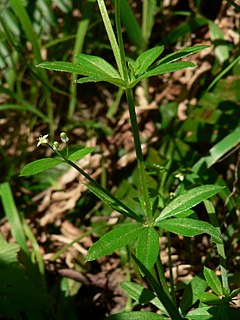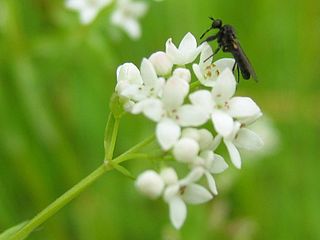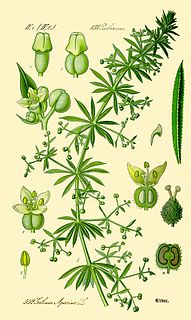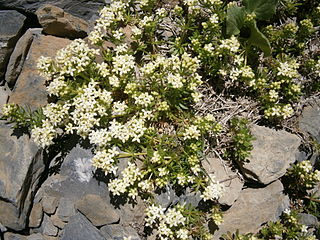
Galium is a large genus of annual and perennial herbaceous plants in the family Rubiaceae, occurring in the temperate zones of both the Northern and Southern Hemispheres. Some species are informally known as bedstraw.

Galium verum is a herbaceous perennial plant of the family Rubiaceae. It is widespread across most of Europe, North Africa, and temperate Asia from Palestine, Lebanon and Turkey to Japan and Kamchatka. It is naturalized in Tasmania, New Zealand, Canada, and the northern half of the United States. It is considered a noxious weed in some places.

Galium triflorum is a herbaceous plant of the family Rubiaceae. It is widespread in northern Europe, eastern Asia and North America. The plant is considered a noxious weed in New York, Pennsylvania, Vermont, New Hampshire, Connecticut and Massachusetts.

Galium album, the white bedstraw or hedge bedstraw, is a herbaceous annual plant of the family Rubiaceae.

Galium mollugo, common name hedge bedstraw or false baby's breath, is a herbaceous annual plant of the family Rubiaceae. It shares the name hedge bedstraw with the related European species, Galium album.

Galium palustre, the common marsh bedstraw or simply marsh-bedstraw, is a herbaceous annual plant of the family Rubiaceae. This plant is widely distributed, native to virtually every country in Europe, plus Morocco, the Azores, Turkey, Turkmenistan, Western Siberia, Greenland, eastern Canada, St. Pierre & Miquelon, and parts of the United States. The species is classified as a noxious weed in New York, Pennsylvania, Massachusetts, Connecticut, Vermont and New Hampshire. It is considered naturalized in Kamchatka, Australia, New Zealand and Argentina.

Galium boreale or northern bedstraw is a plant species of the Rubiaceae. It is widespread over the temperate and subarctic regions of Europe, Asia and North America including most of Canada and the northern United States.

Galium arenarium or sand bedstraw is a plant species of the genus Galium. It grows on beaches and sand dunes along the Atlantic coast of western France and northern Spain.

Galium saxatile or heath bedstraw is a plant species of the genus Galium. It is related to cleavers.

Galium sylvaticum, commonly known as Scotch mist or wood bedstraw, is a plant species of the genus Rubiaceae. Its genus name, Galium, is derived from the Greek word for "milk," apparently because some species have been used to curdle milk.

Gaston Eugène Marie Bonnier was a French botanist and plant ecologist. The standard author abbreviation Bonnier is used to indicate this person as the author when citing a botanical name. Bonnier first studied at École Normale Supérieure in Paris from 1873 to 1876. Together with Charles Flahault, he studied at Uppsala University in 1878. They published two articles about their impressions:

Philippe-Isidore Picot de Lapeyrouse or La Peirouse, Baron de Lapeyrouse (20 October 1744 in Toulouse – 18 October 1818 in château de Lapeyrouse was a French naturalist.

Galium aparine with many common names including hitchhickers, cleavers, clivers, bedstraw, goosegrass, catchweed, stickyweed, sticky bob, stickybud, stickyback, robin-run-the-hedge, sticky willy, sticky willow, stickyjack, stickeljack, grip grass, sticky grass, bobby buttons, whippysticks and velcro plant, is an annual, herbaceous plant of the family Rubiaceae.

Galium aristatum, the awned bedstraw, is a plant species in the Rubiaceae, currently accepted as a distinct species. It is native to the Alps and the Pyrenees Mountains of Europe. It is also reportedly naturalized in a few places in New York State in the United States.

Galium verrucosum, common name warty bedstraw (US) or southern cleavers (UK), is a species of plants in the Rubiaceae. The epithet "verrucosum" means "warty" in reference to the numerous bumps on the mature fruit. It is native to the Mediterranean Basin from Portugal and Morocco to Turkey and Palestine. It is reportedly naturalized in Great Britain, Central Europe, the Canary Islands, Madeira, and Wayne County (Michigan).

Galium elongatum is a species of plants in the Rubiaceae. It is widespread across most of Europe, North Africa and the Middle East from Turkey to Palestine to Iran.
Galium laevigatum is a species of plants in the Rubiaceae. It is native to the mountains of southern and Central Europe: the Alps, the Pyrenees and the Apennines. It has been recorded from Italy, Switzerland, France, Spain, Portugal, Austria, Slovenia and Croatia.

Galium megalospermum, the Swiss bedstraw or big-seeded bedstraw, is a plant species in the Rubiaceae. It is native to the Alps in Central Europe.
Galium obliquum is a species of plants in the Rubiaceae. It is native to the Alps along the border between France and Italy, and as far south as Tuscany and as far west as Tarn-et-Garonne.
Ulmus glabra 'Pyrenaica' is a local cultivar of the Wych Elm, described as Ulmus pyrenaica, the Pyrenees Elm, by de Lapeyrouse in Supplément à l'Histoire abrégée des plantes des Pyrénées (1818), from trees in the Port [:pass] de la Picade in the Basses-Pyrenees. Chevalier added a further description in 'Les Ormes de France' (1942), and a second provenance in the nearby Bagnères-de-Luchon area. Herbarium specimens are held in the Muséum national d'histoire naturelle in Paris, where U. campestris var. montana latifolia is given as a synonym.
















